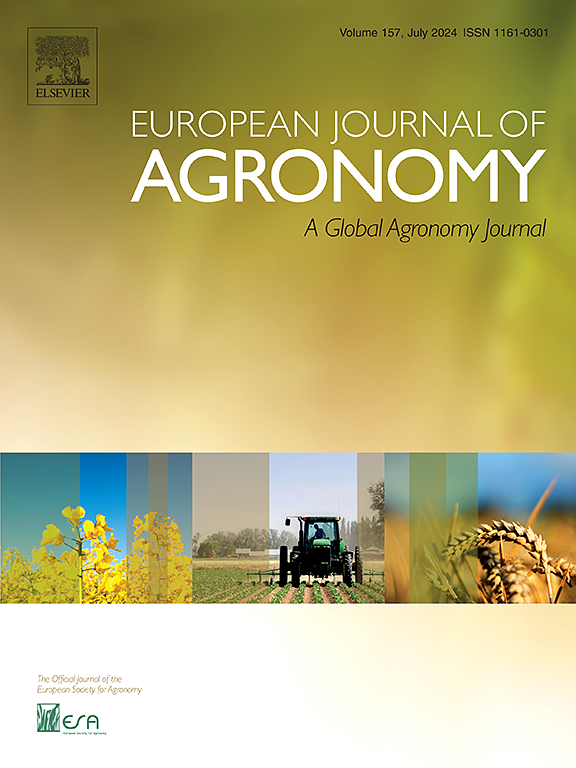Risk-return trade-offs in diversified cropping systems under conservation agriculture: Evidence from a 14-year long-term field experiment in north-western India
IF 4.5
1区 农林科学
Q1 AGRONOMY
引用次数: 0
Abstract
Conservation agriculture practices are promoted to increase productivity, profitability, and sustainability across diverse cropping systems. Many studies have used these goals in decision support frameworks to identify the most effective treatment among those examined. While this approach is valuable, it lacks actionable guidance for farmers regarding maximizing return, while minimizing risk. It does not provide specific recommendations on how to allocate land across various cropping systems and tillage practices to achieve such objectives. This would require another long-term experiment exploring various combinations of treatments. To address this challenge, we propose the application of modern portfolio theory, specifically leveraging mean-variance and conditional value at risk optimization models. Using these models has enabled us to identify the optimal cropping system combinations with different tillage practices that maximized yield and net returns with minimal associated risk. The proposed approach allows for recommendations involving combinations of treatments that may not have been previously tested in a geography. In a 14-year long-term conservation agriculture study involving twelve combination of tillage and cropping systems, we showed how different combination of treatments differ in risk-return profile using mean-variance and conditional value-at-risk models that trace out a frontier of options—combinations of treatments that give highest returns at minimal risk. For example, we find that across risk neutral (most profitable) and most risk averse (lowest risk) farmers, the optimal treatments on the frontier encompass of maize-mustard-mungbean (MMuMb) under zero tillage and maize-wheat-mungbean (MWMb) under bed planting (which offer high returns and associated risk), maize-maize-Sesbania (MMS) under zero tillage (providing a balance of moderate returns and risk), and MMS under conventional tillage (yielding lower returns and risk). Additionally, risk-averse farmers stand to gain by diversifying their land allocation. For instance, they could allocate 54 % of their land to MMuMb under zero tillage and 46 % to MWMb under bed planting to target net returns of INR 1,32,000, with downside risk of INR 56,000, otherwise they can allocate 44 % and 56 % of their land to MMS under zero tillage and MWMb under bed planting, respectively, with a targeted net return of INR 1,22,000 and downside risk of INR 43,540. This highlights the nuanced trade-off between risk and return in maize based diversified cropping systems under different tillage practices. Leveraging mean-variance and conditional value at risk optimization models in the analysis of long-term experiments can yield novel treatment combinations that hold promise and can be recommended to farmers for implementation.
保护性农业下多样化种植系统的风险收益权衡:印度西北部 14 年长期田间试验的证据
推广保护性耕作法的目的是在各种耕作制度中提高生产率、收益率和可持续性。许多研究在决策支持框架中使用了这些目标,以便在所研究的方法中找出最有效的方法。虽然这种方法很有价值,但它缺乏对农民在最大化收益的同时最小化风险的可操作指导。它没有就如何在各种耕作制度和耕作方式中分配土地以实现这些目标提出具体建议。这就需要再进行一次长期试验,探索各种处理方法的组合。为了应对这一挑战,我们建议应用现代投资组合理论,特别是利用均值-方差和条件风险价值优化模型。利用这些模型,我们能够确定不同耕作方法的最佳耕作制度组合,从而在相关风险最小的情况下实现产量和净收益最大化。所建议的方法允许提出涉及处理组合的建议,而这些处理组合以前可能未在某一地域进行过测试。在一项为期 14 年的长期保护性农业研究中,涉及到 12 种耕作和种植系统组合,我们利用均值方差和条件风险价值模型展示了不同的处理组合在风险收益方面的差异,该模型可追溯出选择方案的前沿--以最小风险获得最高收益的处理组合。例如,我们发现,在风险中性(最有利可图)和最厌恶风险(风险最低)的农民中,前沿上的最佳处理包括零耕作下的玉米-芥菜-绿豆(MMuMb)和床面种植下的玉米-小麦-绿豆(MWMb)(提供高回报和相关风险)、零耕作下的玉米-玉米-西番莲(MMS)(提供中等回报和风险的平衡)以及传统耕作下的玉米-玉米-西番莲(MMS)(产生较低的回报和风险)。此外,规避风险的农民可以通过土地分配多样化来获益。例如,他们可以将 54% 的土地分配给零耕作下的 MMuMb,46% 的土地分配给床下种植的 MWMb,目标净收益为 1,32,000 印度卢比,下行风险为 56,000 印度卢比;否则,他们可以将 44% 和 56% 的土地分别分配给零耕作下的 MMS 和床下种植的 MWMb,目标净收益为 1,22,000 印度卢比,下行风险为 43,540 印度卢比。这凸显了不同耕作方式下以玉米为基础的多样化种植系统在风险和收益之间的微妙权衡。在长期试验分析中利用均值-方差和条件风险值优化模型,可以得出有前景的新型处理组合,并推荐给农民实施。
本文章由计算机程序翻译,如有差异,请以英文原文为准。
求助全文
约1分钟内获得全文
求助全文
来源期刊

European Journal of Agronomy
农林科学-农艺学
CiteScore
8.30
自引率
7.70%
发文量
187
审稿时长
4.5 months
期刊介绍:
The European Journal of Agronomy, the official journal of the European Society for Agronomy, publishes original research papers reporting experimental and theoretical contributions to field-based agronomy and crop science. The journal will consider research at the field level for agricultural, horticultural and tree crops, that uses comprehensive and explanatory approaches. The EJA covers the following topics:
crop physiology
crop production and management including irrigation, fertilization and soil management
agroclimatology and modelling
plant-soil relationships
crop quality and post-harvest physiology
farming and cropping systems
agroecosystems and the environment
crop-weed interactions and management
organic farming
horticultural crops
papers from the European Society for Agronomy bi-annual meetings
In determining the suitability of submitted articles for publication, particular scrutiny is placed on the degree of novelty and significance of the research and the extent to which it adds to existing knowledge in agronomy.
 求助内容:
求助内容: 应助结果提醒方式:
应助结果提醒方式:


